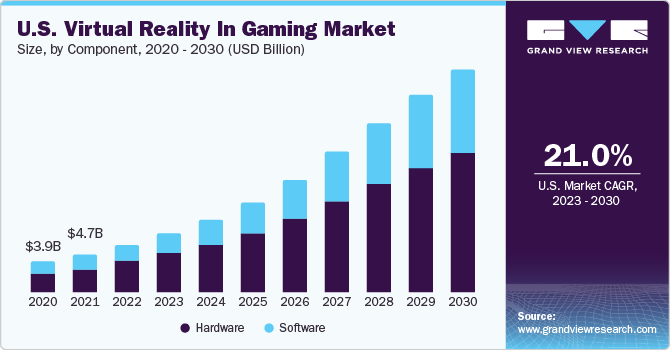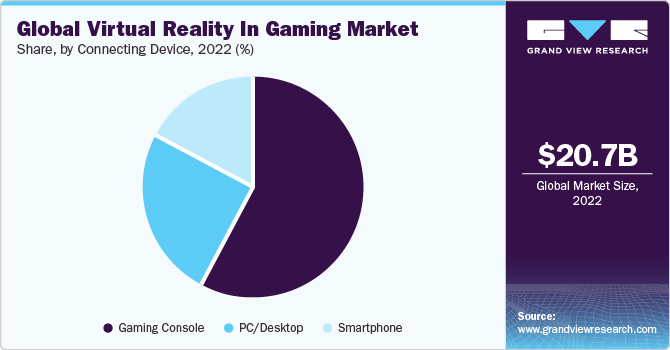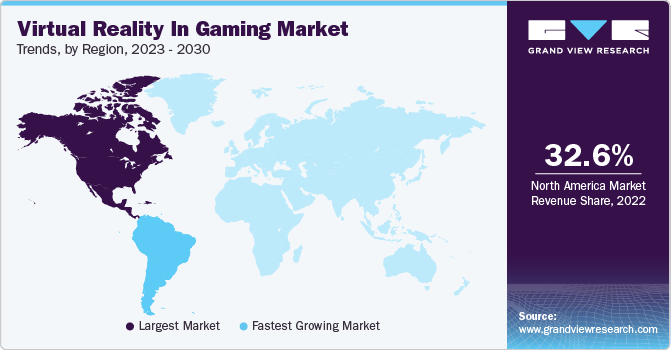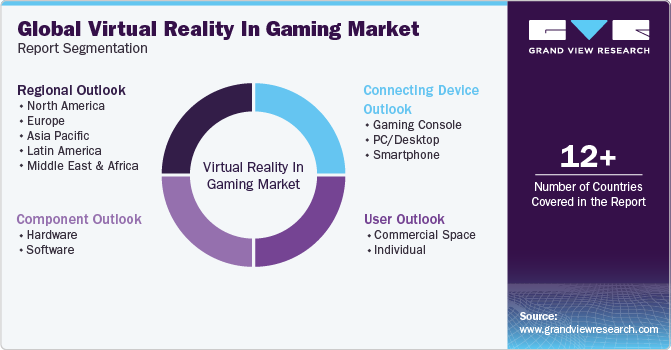- Home
- »
- Next Generation Technologies
- »
-
Virtual Reality In Gaming Market Size & Share Report, 2030GVR Report cover
![Virtual Reality In Gaming Market Size, Share & Trends Report]()
Virtual Reality In Gaming Market Size, Share & Trends Analysis Report By Component, By Connecting Device (Gaming Console, PC/ Desktop, Smartphone), By User (Commercial Space, Individual), By Region, And Segment Forecasts, 2023 - 2030
- Report ID: 978-1-68038-585-4
- Number of Report Pages: 145
- Format: PDF, Horizon Databook
- Historical Range: 2018 - 2021
- Forecast Period: 2023 - 2030
- Industry: Technology
Virtual Reality In Gaming Market Trends
The global virtual reality in gaming market size was valued at USD 20.73 billion in 2022 and is anticipated to grow at a compound annual growth rate (CAGR) of 22.7% from 2023 to 2030. Virtual Reality (VR) has enhanced gaming experience by offering a real-time ability to take gamers into their screens. The industry delivers gamers with alluring virtual accessories that improve user engagement along with immersive involvement. Incessant upgrades in the prevailing technologies comprising motion tracking, 3D effects, and interactive graphics for drawing players’ attention are expected to drive industry growth. Users are demanding newfangled sources of entertainment due to the surge in their spending capacity and are, hence, seen to be engaging in virtual reality games.

The virtual reality gaming space is expanding its professional value with the assistance of innovations. Awareness of state-of-the-art VR accessories, such as headsets, bodysuits, and gloves, is rapidly growing amongst players. VR headsets that were commercially launched in 2016 were a revolution in the recreation industry. The launch resulted in an upsurge in demand for virtual reality games as users were eager to encounter the 3D characters in their virtual surroundings. VR gadgets utilized in the market are empowered with intelligent interactive hardware and software, augmenting the entertainment experience for users.
The rapid advancement in the development of virtual reality peripherals that compatible desktops and game consoles reinforce is likely to drive industry growth. With several startups venturing into virtual reality in the gaming space, the industry for wearable components such as Head-Mounted Displays (HMDs), bodysuits, motion trackers, and gloves, among others, is probable to witness a surging demand by gaming enthusiasts. The devices are launched in a phased manner initially in a few countries. For instance, the HTC Vive has been initially made commercially available in only 24 countries.
Investors and entrepreneurs have been showing singular interest in the virtual reality space for the past five years. The considerable investments in immersive technology across tech-based companies are notifying the upcoming trend in the entertainment and computing business. According to NASSCOM, in the last five years, content creation tools have received 43.5% of the total funding for VR. It indicates the augmented need to ensure superior content development to maintain the interest, demand, and supply of immersive experiences through virtual reality.
Companies are continually engaged in R&D activities to launch technologically advanced products and gain an edge over their competitors. In virtual reality in the gaming market, players are manufacturing accessories extending from motion-sensing devices to treadmills, gloves, arms, and even full bodysuits. For instance, in July 2019, Teslasuit launched its full-body VR haptic suit, which delivers a hyper-accurate illustration of sensations and captures biometrics. The growing demand for VR accessories and wearables amongst users and their probable price fall in the coming seven years is anticipated to drive the virtual reality in gaming market growth. Nevertheless, device compatibility limitation is a challenge that poses a barrier to the industry’s growth.
Connecting Device Insights
The gaming console segment accounted for the largest revenue share of 58.0% in 2022. Based on the connecting devices used for virtual reality gaming, the market has been classified into gaming consoles, PC/desktops, and smartphones. Sony Corporation and Microsoft have proclaimed their new consoles, which are predicted to contain solid-state hard drives, backward compatibility, higher frame rates, and superior-quality virtual reality support. These new consoles are anticipated to drive industry growth in the coming years.
The PC/desktop segment is expected to expand at the fastest CAGR of 26.5% during the forecast period. Some entertainment-based computer companies, such as ORIGIN PC Corporation and CYBERPOWERPC, also offer customizations for PCs as per the users’ requirements. The VR gaming experience on the PC/ desktop depends largely on the Graphics Processing Unit (GPU) and the RAM incorporated in it. Chip fabricators such as NVIDIA Corporation and Advanced Micro Connecting Devices, Inc. are continuously upgrading their offerings to suit the ever-growing market.

The smartphone segment is expected to show significant growth during the forecast period. This growth can be attributed to the ubiquity of smartphones and the ease and price at which they are available. The advancements in the GPU and processor of smartphones are expected to drive the segment. VR games are reaching an all-new set of users who are not necessarily identified as gamers but are spending many hours on such content using their smartphones. Consumers in China and India are largely seen to be using their smartphones or tablets for playing, which complements the segment growth.
Component Insights
The hardware segment held the largest revenue share of 63.7% in 2022. It is attributed to the continual upgrades in VR wearables and accessories, including input devices, masks, gloves, headsets, and bodysuits. Hardware includes any physical component for playing, such as gaming platforms, storage media, accessories, and gaming kits. There is a steady demand for input devices that are requisite for playing virtual reality games. The most renowned input devices include Oculus Rift, PlayStation VR, HTC Vive, and Samsung Gear VR.
The software segment is expected to expand at the fastest CAGR of 24.1% over the forecast period. The software segment is likely to experience modest growth as compared to the hardware segment, which is projected to witness rapid growth. VR surroundings and effects are produced using VR software to edge the environment as close as possible to reality. The challenge for the software industry, on the other hand, is to develop software and games that create a much more captivating and appealing effect for players.
Regional Insights
North America dominated the market and accounted for the largest revenue share of 32.6% in 2022. The U.S. accounted for significant growth as the region has been observing higher deployment due to the early adoption of new technologies and similar consumer preferences. European regions are anticipated to witness steady growth due to the increasing investments in the virtual reality domain. Germany, being the gaming hub, is witnessing a surge in VR gaming arcades, free, and escape rooms.

Latin America is expected to expand at the fastest CAGR of 24.9% during the forecast period. The increasing number of start-ups in the virtual reality space, rising crowdfunding, growing console sales and substantial gamer base make the region a lucrative market for VR-based recreation. The industry is beholding Brazil, Mexico, UAE, Saudi Arabia, Bahrain, and Israel as upcoming hubs for VR in the gaming industry.
Asia Pacific is expected to witness significant growth over the forecast period. Within the region, China and Japan accounted for a higher market share owing to the vast consumer base and increased adoption of VR games on smartphones. The region is expected to witness huge adoption of the technology, which is also aided by high-speed 5G network deployment, thus enhancing gaming involvement. Countries such as South Korea and India are expected to observe significant demand for VR games owing to the technological advancements in the entertainment industry and rising disposable income.
User Insights
The commercial space segment accounted for the largest revenue share of around 40.2% in 2022 and is expected to expand at the fastest CAGR over the forecast period. There is a considerable rise in the number of VR gaming zones and arcades worldwide owing to their ability to let consumers completely isolate themselves from the real and experience the simulated world created in that space. Youngsters are more attracted to commercial spaces such as arcades, cafes, and amusement parks as they offer superior virtual reality gaming experiences at moderate costs on an hourly basis. Commercial spaces deliver a premium experience with large open areas and enhanced VR interactions, giving users a more immersive involvement.
The individual segment is expected to witness significant growth over the forecast period. The most alluded factor to restrict the elevated consumer adoption of VR in gaming is cost. However, the accessibility and availability of VR games at the users’ homes and at dropping prices of hardware over the period attributed to segment dominance in the industry. Industry players are coming up with cost-effective gadgets to penetrate the market as well as widen their consumer base. For instance, the cardboard headset launched by Google, LLC. is an HMD that can be used with a smartphone for experiencing the simulated world of the electronic game. The unceasing efforts of companies to infiltrate the market and reach maximum customers are expected to drive the segment growth.
Key Companies & Market Share Insights
Intense competition among key industry players has shifted the focus of the companies to cost-effectiveness, innovation, and quality of the VR hardware, content, and software. The transition from one generation of gaming consoles to another usually takes five to six years. Sellers are continually involved in technological upgrades and pass them to gamers. Major market players are focusing on strengthening their product portfolio in a bid to sustain their leading market position.
Companies are engaged in regional expansion, mergers, acquisitions, and strategic collaborations to expand their business at global and regional levels. For instance, in February 2023, Sony Interactive Entertainment (SIE) announced the worldwide release of PlayStation VR2 (PS VR2), their highly anticipated next-generation virtual reality (VR) gaming headset designed for consumers. The headset boasts an array of cutting-edge features, including high-fidelity visuals, innovative sensory enhancements, and improved tracking capabilities.
Key Virtual Reality In Gaming Companies:
- Sony Corporation
- Microsoft
- Nintendo.Games
- Linden Research, Inc.
- Electronic Arts Inc.
- Meta
- SAMSUNG
- Google Inc.
- HTC Corporation
- Virtuix
- Ultraleap Limited
- Tesla Studios
- Qualcomm Technologies, Inc.
- Lucidcam.com
Recent Developments
-
In June 2023, Meta Platforms (META) introduced a VR gaming subscription service, a strategic move aimed at potentially enhancing its revenue stream. According to this initiative, subscribers can retain the games for as long as they remain active members of Meta Quest+. Meta labeled this subscription plan as "the most affordable way to expand your library with exceptional content."
-
In November 2022, Meta launched the XTADIUM app on Meta Quest, providing customers with an immersive 180-degree VR experience of their favorite sports. The app offers real-time statistical overlays and up to eight different camera angles for users to choose from. Additionally, viewers can enjoy the event alone or create private watch parties to share the experience with friends.
-
In October 2022, Microsoft announced a partnership with Meta to deliver a VR experience. The collaboration aimed to bring Microsoft's productive tools to VR headsets while supporting Meta's grand Metaverse plan.
-
In April 2021, Oculus VR partnered with independent studio Armature Capcom to release the Resident Evil 4 VR remake exclusively on Oculus Quest 2. Facebook, the parent company, held onto its Quest platform to showcase this highly anticipated VR gaming experience.
-
In May 2020, Apple Inc. made a significant acquisition by purchasing NextV, a virtual gaming company based in California. This strategic move bolstered Apple's efforts in the gaming, sports, and entertainment field. Furthermore, with NextVR's impressive portfolio of 40 patents, the company gained the capability to elevate the quality of video streams, opening up new possibilities for enhanced user experiences.
Virtual Reality In Gaming Market Report Scope
Report Attribute
Details
Market size value in 2023
USD 26.11 billion
Revenue forecast in 2030
USD 109.59 billion
Growth Rate
CAGR of 22.7% from 2023 to 2030
Base year for estimation
2022
Historical data
2018 - 2021
Forecast period
2023 - 2030
Report updated
December 2023
Quantitative units
Revenue in USD million/billion and CAGR from 2023 to 2030
Report coverage
Revenue forecast, company ranking, competitive landscape, growth factors, and trends
Segments covered
Component, connecting device, user, region
Regional scope
North America; Europe; Asia Pacific; Latin America; MEA
Country scope
U.S.; Canada; UK; Germany; France; China; Japan; India; Australia; South Korea; Brazil; Mexico; Saudi Arabia; South Africa; UAE
Key companies profiled
Sony Corporation; Microsoft; Nintendo.Games; Linden Research, Inc.; Electronic Arts Inc.; Meta; SAMSUNG; Google Inc.; HTC Corporation; Virtuix; Ultraleap Limited; Tesla Studios; Qualcomm Technologies, Inc.; Lucidcam.com
Customization scope
Free report customization (equivalent up to 8 analyst’s working days) with purchase. Addition or alteration to country, regional & segment scope
Pricing and purchase options
Avail customized purchase options to meet your exact research needs. Explore purchase options
Global Virtual Reality In Gaming Market Report Segmentation
This report forecasts revenue growth at global, regional, and country levels and provides an analysis of the latest industry trends in each of the sub-segments from 2018 to 2030. For this study, Grand View Research has segmented the global virtual reality in gaming market report based on component, connecting device, user, and region:

-
Component Outlook (Revenue, USD Million, 2018 - 2030)
-
Hardware
-
Software
-
-
Connecting Device Outlook (Revenue, USD Million, 2018 - 2030)
-
Gaming Console
-
PC/Desktop
-
Smartphone
-
-
User Outlook (Revenue, USD Million, 2018 - 2030)
-
Commercial Space
-
Individual
-
-
Regional Outlook (Revenue, USD Million, 2018 - 2030)
-
North America
-
U.S.
-
Canada
-
-
Europe
-
UK
-
Germany
-
France
-
-
Asia Pacific
-
China
-
Japan
-
India
-
Australia
-
South Korea
-
-
Latin America
-
Brazil
-
Mexico
-
-
Middle East and Africa
-
Saudi Arabia
-
South Africa
-
UAE
-
-
Frequently Asked Questions About This Report
b. The global virtual reality in gaming market size was estimated at USD 20.73 billion in 2022 and is expected to reach USD 26.11 billion in 2023.
b. The global virtual reality in gaming market is expected to grow at a compound annual growth rate of 22.7% from 2023 to 2030, to reach USD 109.59 billion by 2030.
b. North America dominated the virtual reality in gaming market with a share of over 32.0% in 2022. This is attributable to the early adoption of new technologies and similar consumer preferences.
b. Some key players operating in the virtual reality in gaming market include Linden Labs; Electronic Arts; Meta; Samsung Electronics Co. Ltd.; Google Inc.; HTC Corporation; Virtuix; Leap Motion Inc.; and Qualcomm Incorporated.
b. Key factors that are driving the virtual reality in gaming market growth include the rising demand for gaming among the young population, increasing competitiveness in the virtual reality gaming space, and increasing disposable income of buyers in developing countries.
Share this report with your colleague or friend.
![gvr icn]()
NEED A CUSTOM REPORT?
We can customize every report - free of charge - including purchasing stand-alone sections or country-level reports, as well as offer affordable discounts for start-ups & universities. Contact us now
![Certified Icon]()
We are GDPR and CCPA compliant! Your transaction & personal information is safe and secure. For more details, please read our privacy policy.
We are committed towards customer satisfaction, and quality service.
"The quality of research they have done for us has been excellent."





